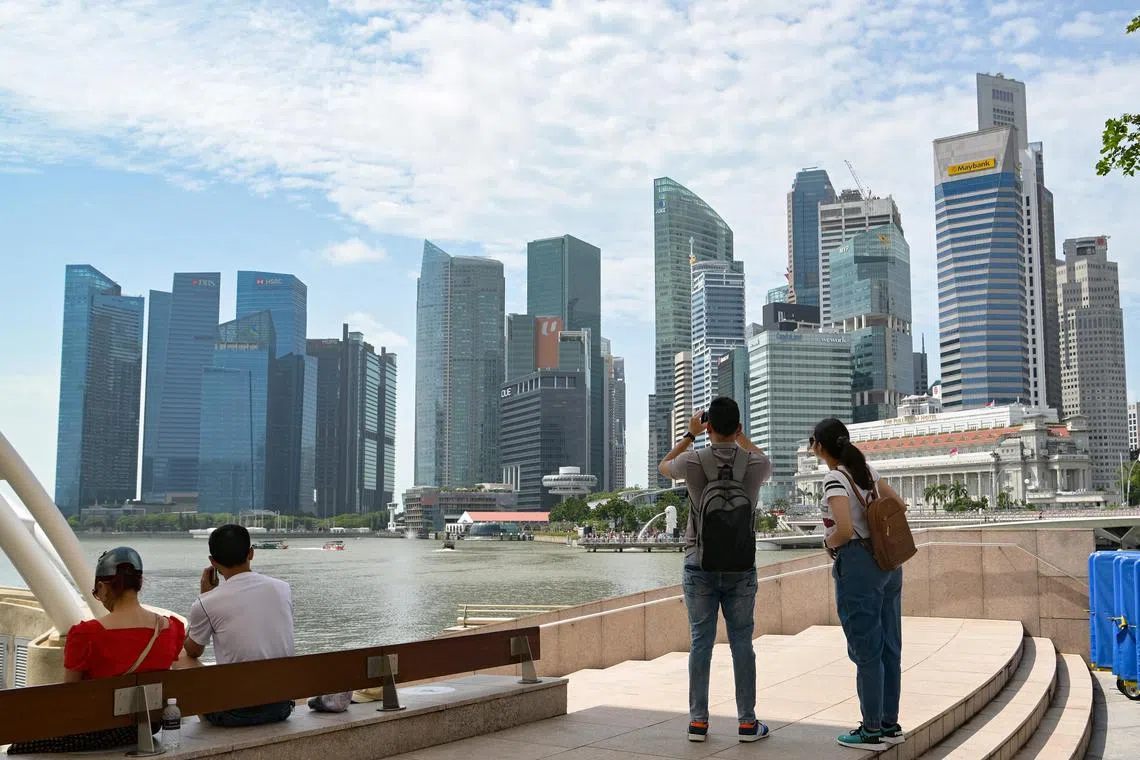Inflation, China reopening and US recession to define S’pore’s economic growth in 2023
Sign up now: Get ST's newsletters delivered to your inbox

Even as inflation has shown signs of peaking in recent months, central banks are not telegraphing their intent to put a stop to their interest rate hiking cycles.
ST PHOTO: LIM YAOHUI
Follow topic:
SINGAPORE – Following a multitude of crises and shocking events in 2022, there is growing consensus that, in terms of the economy, things will get better from now on.
Economists in Singapore, as well as worldwide, are in agreement that as economic growth slows to a near halt in 2023, inflation will continue to retreat, the United States – the world’s largest economy – will avoid a deep and prolonged recession
Of course, the global economy went through a lot in 2022
Recovery from Covid-19-induced recession was hobbled by surging inflation, supply chain disruptions, a war in Europe, a worsening geopolitical conflict
Ironically, this ubiquity of white swans – risks visible on the horizon – is boosting confidence that investors and policymakers are now better prepared to manage any crisis that might arise this year.
Most of Singapore’s economic growth comes from exports, and the bulk of its inflation from imports. Hence, the Republic’s economy can be used to benchmark how complacent global markets are to the still-emerging risks to the growth and inflation dynamics.
Singapore’s Ministry of Trade and Industry is forecasting for 2023 a gross domestic product growth of 0.5 per cent to 2.5 per cent. The wide range of this prediction shows how limited the upside potential is. The downside is, however, much closer to a slump into recession.
Meanwhile, headline inflation – which includes all items – will continue to rise from an average of around 6 per cent in 2022 to as high as 6.5 per cent in 2023, taking into account the goods and services tax increase in January, according to the Monetary Authority of Singapore (MAS).
This shows how unrelenting inflation is despite the growth slowdown observed in the second half of the year.
Mr Euben Paracuelles, senior economist at Japanese investment bank Nomura, said: “After seeing the strongest recovery in the region from the pandemic, Singapore’s very open economy will likely be one of the worst-hit by a global growth downturn.
“Despite a significant growth slowdown, underlying inflation pressures may persist.”
Nomura expects Singapore’s GDP growth in 2023 to be 1.4 per cent, with headline inflation at 4.6 per cent.
But most investment banks worldwide expect a shallow recession in the US and Europe – which will turn the tide on inflation in the first half of 2023 – and then a steady recovery through the second half of the year, which, combined with China’s reopening, will boost Asia’s economic fundamentals.
Such optimism at the end of the year, however, can lead to major disappointments in the new year. There are already enough red flags to douse the cheer.
International Monetary Fund (IMF) managing director Kristalina Georgieva said earlier in December that the chance of global growth falling below 2 per cent in 2023
That is a stark warning from the IMF, which only in October had cut its global growth forecast for 2023 to 2.7 per cent from 2.9 per cent in July.
Mr Tai Hui, managing director and chief market strategist for Asia at JP Morgan Asset Management, said a gloomier outlook mainly arises from the potential for miscalculation by central banks on how restrictive monetary policy needs to be to control inflation.
“When economic activity is already weak, a second energy shock would likely have a more significant impact,” he said, referring to the Russia-Ukraine conflict and its impact on global energy prices.
“There are clear reasons the pace of inflation would fall in 2023, but the path downwards and the end point are still up for debate,” he added.
The impact of the lightning pace at which central banks have raised their benchmark interest rates in 2022 is already showing in credit markets worldwide.
The amount of distressed debt, owed by companies likely to face difficulty in paying it back, has soared by 300 per cent in the year, according to data compiled by Bloomberg. Globally, almost US$650 billion (S$870.4 billion) in bonds and loans are in distress territory, the data showed.
Even as inflation has shown signs of peaking in recent months, central banks are not telegraphing their intent to put a stop to their interest rate hiking cycles.
If recessions start to roll across major economies in 2023, high interest rates will prompt a string of debt defaults and bankruptcies, and test the market’s faith in the resilience of corporate balance sheets.
Mr Azad Zangana, senior economist and strategist at asset management firm Schroders, said central banks are now actively trying to slow growth to lower inflation – which is at its highest level in decades – even if it means causing recessions.
“The scale of inflation means that interest rates have to rise further in the short term and remain higher for longer, with central banks unlikely to loosen policy to support growth for some time,” he said.
If the US Federal Reserve raises its fund rates beyond the anticipated 5 per cent, the odds will rise, not just for recession in the US, but for a credit market blow-out as well.
Hence, betting on a weakening US dollar could go horribly wrong. In fact, signs of financial distress may send global money managers to the safety of the US debt market, now offering decade-high yields, and in the process boost the US dollar and further tighten financial conditions worldwide.
Many old-timers who have observed the boom and bust cycles closely, such as former US Treasury secretary Larry Summers, have recently warned that recessions are caused by a significant jump in unemployment followed by a collapse in demand.
And when they take hold, macroeconomic stability and financial markets start to slide fast.
Inflation, on the other hand, is usually sticky; prices tend to jump and then stay higher for longer until the recession fuelling collapse in demand arrives.
That is why DBS Bank senior economist Irvin Seah expects headline inflation in Singapore to average 6.3 per cent in 2023, notwithstanding five rounds of tightening by the MAS and visible signs of global inflationary pressure abating.
Even as the knock-on impact of slower growth on demand and the labour market could make for a lower inflation reading, a 1 percentage point hike in GST will offset the trajectory of the inflation readings for the full year, Mr Seah said.
The final factor for the optimistic outlook is China, where the abrupt abandonment of its zero-Covid policy
Economic activity is rebounding in Chinese cities, where Covid-19 infections appear to have peaked. But mobility is still slumping in many parts of the country, including Shanghai and Shenzhen, that are crucial to the global supply chains linking the manufacturing powerhouse with the rest of the world.
Mr Seah said China’s unwinding of Covid-19 measures in 2023 will be pivotal for Singapore’s growth outlook.
“If further easing of China’s Covid-19 measures ensues, the pent-up demand could be significant for the region. That said, China’s Covid-19 policy is a wild card, and we prefer to take a cautious view for now, given the high degree of uncertainty,” he said.


